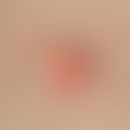Synonym(s)
HistoryThis section has been translated automatically.
DefinitionThis section has been translated automatically.
Rare multifocal neurocutaneous malformation syndrome characterized by variably expressed hamartomas of the skin, CNS, eyes, heart, and kidneys. Clinically suggestive is the DMD triad of:
- Acne-like centrofacial and periungual angiofibromas.
- mental retardation and
- Epilepsy.
Tuberous sclerosis is classically included in the so-called phakomatoses . These are syndromes whose common feature is the occurrence of hamartomas in several organ systems.
Other diseases classified as phakomatoses include the following
- neurofibromatosis type I
- Retino-cerebellar angiomatosis (Hippel-Lindau)
- encephalo-facial angiomatosis (Sturge-Weber)
- Ataxia teleangiectatica (Louis-Bar)
- the Peutz-Jeghers syndrome.
You might also be interested in
Occurrence/EpidemiologyThis section has been translated automatically.
Worldwide spread. Estimated prevalence is 6.8-12.4 /100,000 inhabitants. It is equally distributed among ethnic groups and both sexes.
EtiopathogenesisThis section has been translated automatically.
Autosomal-dominantly inherited (new mutations are frequent; in about 70%) mutations of the genes TSC1 (tuberous sclerosis gene 1; gene locus 9q34) and TSC2 (tuberous sclerosis gene 2; gene locus 16p13.3), which lead to disorders of their gene products, the proteins hamartin (TSC1) and tuberin (TSC2). The disruption of the physiological function of both proteins as growth regulators of nerve cells during embryonic development is being discussed. Both proteins lead to an inhibition of mTOR (mechanistic target of rapamycin complex 1) and thus to tumor suppression. Mutation of one of these proteins leads to dysfunction of the signaling pathway with consecutive increased cell proliferation and formation of tumors. The melanocytic defects can also be traced back to a disruption of mTOR (see under ash leaf spot)
The numerous mutations identified are summarized in the Tuberous Sclerosis Complex Variation Database for TSC1 and TSC2. In 10-15% of patients, however, no mutations (no mutation identified) can be detected (NMI patients).
ManifestationThis section has been translated automatically.
Discrete hypopigmentations are already present at birth (ash leaf spots). A so-called Adenoma sebaceum usually develops only during puberty. Neurological symptoms appear in the course of the first years of life.
ClinicThis section has been translated automatically.
Integument:
- Ash leafspots: The highly characteristic, disc-shaped, light-colored spots of the skin (98%) in a random distribution (see ash leaf spot below) are already impressive at birth. The presence of > 5 ash leaf spots is highly suspicious for tuberous sclerosis. Poliosis (white forelock) is considered an alternative manifestation of hypopigmented patches of skin (note: the use of a Wood's lamp is helpful in detecting ash leaf spots). The hypopigmentation observed in patients with TSC is characterized by a functional disorder of the epidermal and follicular melanocytes. The density of active melanocytes is normal. The dendrites of the melanocytes are poorly developed, the melanosomes are smaller and less melanized than in melanocytes of unaffected skin and hair. The number of melanosomes within the melanocytes is reduced, but without abnormal autophagic aggregation. These dysfunctional melanocytes release fewer melanosomes to the surrounding keratinocytes, so that the overall melanin content in the affected skin and hair is reduced (Jimbow K 1997). For further pathophysiological information, see below. Ash leaf spot.
- Shagreen spots: In addition, skin-colored, to yellow-brownish, disc-shaped, coarsely textured plaques (shagreen spots, also called shagreen spots) appear on the trunk and are often found in the lumbar region. The cause is localized collagen compaction. They usually appear after the age of 5.
- Facial angiofibromas: Only in childhood and during puberty do "acne-typical" facial angiofibromas appear in about 60% of patients (traditional dermatological term: adenoma sebaceum).
- Fibrous forehead plaques: these plaques, histologically diagnosed as angiofibromas, occur in 25% of patients (Northrup H et al. 2013)
- Peri- and subungual (angio-)fibromas on fingers and toes (so-called Koenen tumors) occur as the last dermatological manifestation (observed in about 20% of patients) and do not appear until adolescence or even adulthood.
- Café-au-lait spots are also not uncommon.
- The development of cutis verticis gyrata is very rare.
Extracutaneous manifestations:
- Papular gingival hyperplasia
- Epileptiform seizures are typical of tuberous sclerosis (96%). In the first 2-3 years of life seizures occur focally, later generalized. Mostly intellectual retardation, multiple periventricular calcifications in the CNS (98%).
- Cystic kidney changes up to the full picture of poylcystic kidneys occur with so-called large deletions, which include the PkD1 gene in addition to the TCS2 (tuberin) gene.
- Multilocular angiomyolipomas of the kidney: 38%
- Renal cell carcinomas: 3%
- Adenomas and lipomyomas of the liver
- Congenital angiomas of the retina; achromatic retinal spot
- Adenomas of the pancreas
- Spleen tumors
- Subependymal giant cell astrocytomas of the CNS: 5-15%
- Cardiac rhabdomyoma
- Lymphangioleiomyomatosis of the lung (LAM)
Complex malformations, e.g. situs viscerum inversus completus, skeletal changes (bone cysts, periosteal thickening of the diaphysis of the long tubular bones), honeycomb lung, lung cysts, kidney cysts or double kidney have been described.
TherapyThis section has been translated automatically.
Causal therapies are not known.
Symptomatic local therapy if necessary is in the foreground.
Everolimus: Everolimus, an mTOR inhibitor, has been shown to have positive effects on subependymal giant cell astrocytoma and renal angiomyolipoma in patients with TSC. The results of the "EXIST study" led to the approval of everolimus for both manifestations. Such effects are also expected for sirolimus.
Hyftor (sirolimus) has been approved for the treatment of facial adenofibromas since October 1, 2023.
In the EXIST study, this therapy also led to a reduction in neurological symptoms and facial angiofibromas. Based on these study results, everolimus has also been approved as an adjunctive therapy for refractory, partial epileptic seizures with or without secondary generalization since January 2017 (French JA et al. Lancet 2016).
Genetic counseling is mandatory.
Operative therapieThis section has been translated automatically.
Koenen tumors as well as gingival growths are excised if necessary. In the case of subungual Koenen tumors, the corresponding part of the nail plate must be removed beforehand.
For fibroadenomas and trichoepitheliomas on the face, dermabrasio as well as CO2 laser therapy may be considered. Since the results are often unsatisfactory and no standard therapy can be recommended, it is up to the treating physician to use other therapy methods such as electrocautery with a pointed needle, laser, cryosurgery, if necessary.
For treatment of the so-called adenoma sebaceum see there.
Progression/forecastThis section has been translated automatically.
Note(s)This section has been translated automatically.
Diagnostic criteria for tuberous sclerosis (according to Roach ES et al. 1998)
Major criteria
- Facial angiofibroma or fibrous forehead plaques (Adenoma sebaceum)
- Sub- or periungual fibroids
- > 3 hypomelanotic spots (vitiligo-like depigmentation)
- Lumbo-sacral connective tissue nevus (shagreen patch)
- Multiple nodular hamartomas of the retina
- Sclerosing plaque or tumor of the cerebral cortex
- Subependymal node or giant cell astrocytoma
- cardiac rhabdomyoma
- renal angiomyolipoma
- Lymphangiomatosis
Minor criteria
- Multiple, pit-like enamel defects
- Hamartomatous rectal polyp
- Bone cysts
- Gingival fibroids
- Non-renal hamartoma
- Achromatic retinal spots
- Confetti-like, hypomelanotic spots
- Multiple kidney cysts
For the definitive diagnosis of tuberous sclerosis, either 2 major criteria, or 1 major criterion and 2 minor criteria are required. For the probable diagnosis of tuberous sclerosis, 1 major and 1 minor criterion are sufficient.
LiteratureThis section has been translated automatically.
- Ammari MM et al. (2014) Oral findings in a family with Tuberous sclerosis complex. Spec Care Dentist. doi: 10.1111/scd.12100
- Balzer F, Grandhomme (1886) Nouveau cas d'adénomes sébacés de la face. Arch Physiol 8: 93-96
- Beltle J, Seemann MD (2003) Computed tomographic findings in Bourneville-Pringle disease. Eur J Res 8: 292-294
- Bourneville DM (1880) Sclérose tubéreuse des circonvolutions cérébrales, idiotie et épilepsie hémiplégique. Arch Neurol (Paris) I: 81-91
- Dill PE et al. (2014) Topical everolimus for facial angiofibromas in the tuberous sclerosis complex. A first case report. Pediatr Neurol 51:109-113
- Ebrahimi-Fakhari D et al. (2017) Dermatologic manifestations of tuberous sclerosis.J Dtsch Dermatol Ges 15: 695-701
- French JA et al. (2016) Adjunctive everolimus therapy for treatment-resistant focal-onset seizures
associated with tuberous sclerosis (EXIST-3): a phase 3, randomized, double-blind, placebo-controlled study. Lancet 388:2153-2163. Jimbow K (1997) Tuberous sclerosis and guttate leukodermas. Semin Cutan Med Surg 16:30-35.
- Liebman JJ et al. (2014) Koenen tumors in tuberous sclerosis: a review and clinical considerations for treatment. Ann Plast Surg 73:721-722
- May M et al. (2003) Angiomyolipoma of the kidneys as a rare cause of retroperitoneal hemorrhage. Two case reports with tuberous sclerosis Bourneville-Pringle. Urologist 42: 693-701
- Northrup H et al. (2013) Tuberous sclerosis complex diagnostic criteria update: recommendations of the
2012 Iinternational Tuberous Sclerosis Complex Consensus Conference. Pediatr Neurol 49:243-524. - Pringle JJ (1890) A case of congenital adenoma sebaceum. Brit J Derm 2: 1-14
- Roach ES, Delgado MR (1995) Tuberous sclerosis. Dermatol Clin 13: 151-161
- Roach ES et al (1998) Tuberous sclerosis complex consensus conference: revised clinical diagnostic criteria. J Child Neurol 13:624-628
- Trauner MA et al (2003) Segmental tuberous sclerosis presenting as unilateral facial angiofibromas. J Am Acad Dermatol 49: S164-166
Incoming links (33)
Adenoma sebaceum; Bourneville-brissaud disease; Bourneville disease; Bourneville, m.; Bourneville-pringle syndrome; Brain sclerosis, tuberous; Café-au-lait stain; Central neurinomatosis; Chromosome 9; Dental diseases, skin changes; ... Show allOutgoing links (15)
Adenoma sebaceum; Angiofibroma (overview); Ash-leaf stain; Café-au-lait stain; Cryosurgery; Cutis verticis gyrata; Dermabrasion; Hamartom; Hypopigmentation; Koenen tumour; ... Show allDisclaimer
Please ask your physician for a reliable diagnosis. This website is only meant as a reference.












